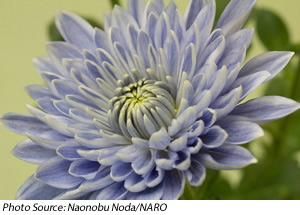
Japanese Scientists Genetically Engineer A True Blue Chrysanthemum
August 2, 2017| |
 Researchers led by plant biologist Naonobu Noda at the National Agriculture and Food Research Organization in Tsukuba, Japan have genetically engineered the world's first true blue chrysanthemum.
Researchers led by plant biologist Naonobu Noda at the National Agriculture and Food Research Organization in Tsukuba, Japan have genetically engineered the world's first true blue chrysanthemum.
True blue flowers are rare in nature, and occur only in selected species such as morning glories and delphiniums. True blue requires complex chemistry. Anthocyanins, the pigment molecules in the petals, stem, and fruit, consist of rings that cause a flower to turn red, purple, or blue, depending on what sugars or other groups of atoms are attached. Conditions inside the plant cell also matter, so simply transplanting an anthocyanin from a blue flower like a delphinium will not really work.
Noda first inserted a gene from the bluish flower Canterbury bell into a chrysanthemum. The gene's protein modified the chrysanthemum's anthocyanin to make the bloom appear purple instead of reddish. To get closer to a true blue, Noda and his team then added a second gene from the blue-flowering butterfly pea. This gene's protein adds a sugar molecule to the anthocyanin. The research team planned to add a third gene, but the chrysanthemum flowers were blue with just the two genes. Chemical analyses revealed that the blue color was possible in just two steps because chrysanthemums already had a colorless component that interacted with the modified anthocyanin to create the blue color.
For more details, read the news article from Science Magazine.
| |
Biotech Updates is a weekly newsletter of ISAAA, a not-for-profit organization. It is distributed for free to over 22,000 subscribers worldwide to inform them about the key developments in biosciences, especially in biotechnology. Your support will help us in our mission to feed the world with knowledge. You can help by donating as little as $10.
-
See more articles:
-
News from Around the World
- Methodological Flaws Found in Studies Reporting Adverse Effects of GM Crops
- Ghana Gov't Supports GE Research to Combat Armyworm
- New Assembly for Bread Wheat Genome has 10x Higher Contiguity
- USDA APHIS Announces Extension of Deregulation to GE Canola
- PABIC and ICCBS Hold ISAAA Report Launch
- CSIRO Decodes Genome of Megapests
- Pangasinan Stakeholders Learn about Bt Brinjal, Affirm Support for Bt Talong
- Study Reports SmartStax Maize Does Not Affect Non-Target Organisms
-
Research Highlights
- RPW8.1 Gene Boosts Pattern-Triggered Immunity against Multiple Pathogens
- Overexpression of Mutated ZmDA1 or ZmDAR1 Gene Improves Maize Yield via Enhanced Starch Synthesis
-
Beyond Crop Biotech
- Japanese Scientists Genetically Engineer A True Blue Chrysanthemum
-
From the BICs
- Pakistan and China to Work Together in Advancing Agriculture
- Challenges in Commercializing Biotech Crops Tackled in Seminar
-
Announcements
- European Biotech Week 2017
-
Plant
- Transcriptional Activation via CRISPR-dCas9 Mimics Overexpression Phenotypes in Arabidopsis
-
Read the latest: - Biotech Updates (April 24, 2024)
- Gene Editing Supplement (April 24, 2024)
- Gene Drive Supplement (February 22, 2023)
-
Subscribe to BU: - Share
- Tweet
